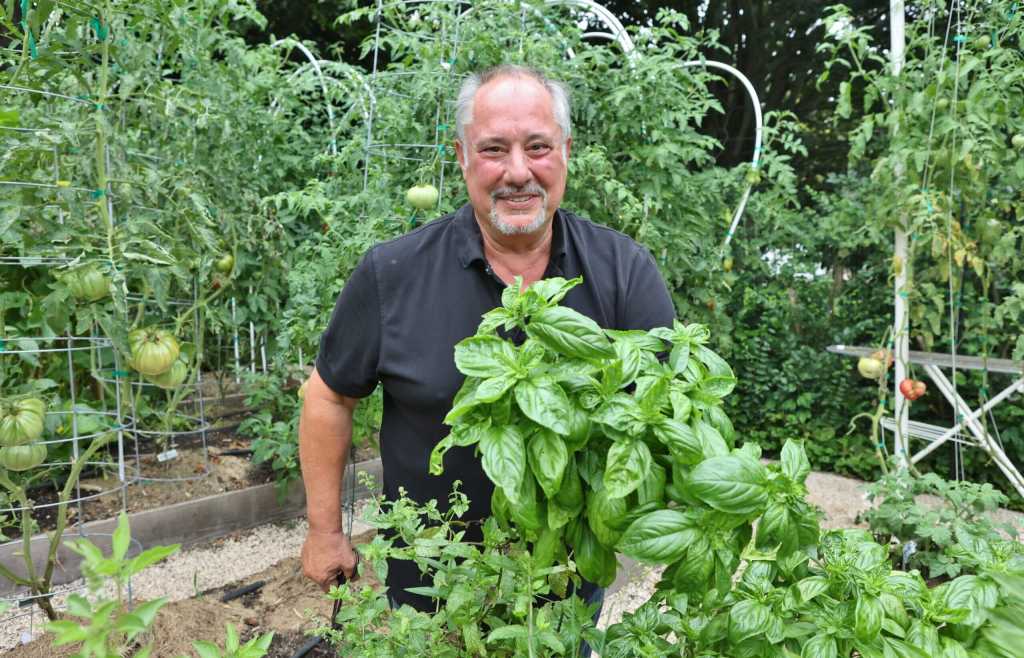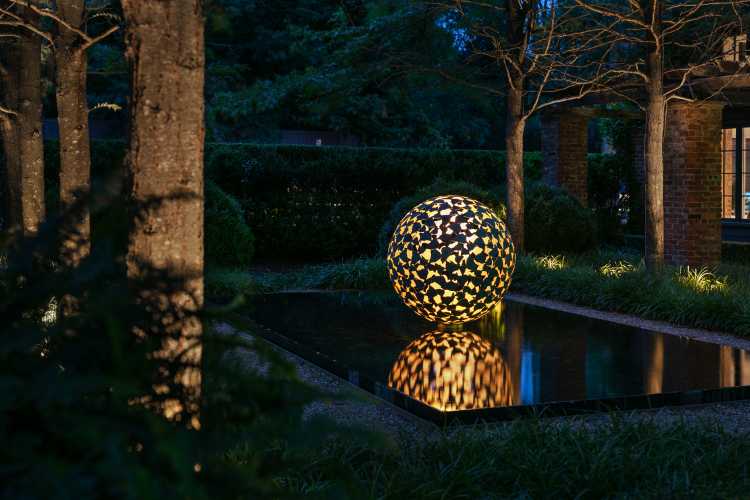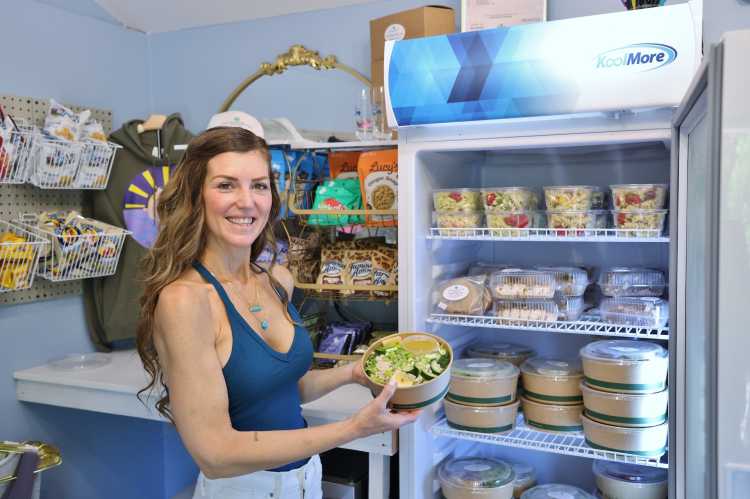Back in Brooklyn, Chef Michael Ayoub is known for his wood-fired pizzas at Fornino, a restaurant with three locations in Greenpoint, at Time Out Market in DUMBO and at Brooklyn Bridge Park. While he always sources the freshest ingredients for his dishes, what some diners may not realize is that the specialty pizzas that end up on his menus are often made with the bounty from his very own home garden in Southampton.
His backyard garden is about 1,000 square feet a bit bigger than your average home garden, packed with hundreds of plants and vegetables — and an extra pop of color from his own hand-blown sculptures that dot the space — with nothing edible going to waste thanks to this chef’s talents and zest to cre- ate. It’s in full bloom this time of year with plenty for Fornino’s specialties. Particularly fresh are the tomatoes, growing on plants anywhere between six and nine feet tall.
“There’s nothing, I mean, nothing, like it,” he says of the freshness of a just-picked vine-ripe tomato off the vine, even though he likes to harvest it right before it’s fully ripe “for the fact that I have to compete with the birds.”
It’s a freshness this veteran restauranteur-chef enjoys bringing to his diners.
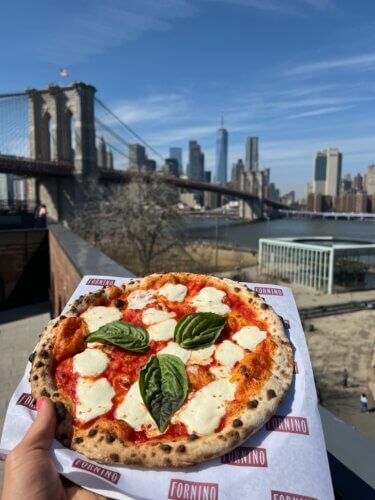
Though a small garden like his cannot supply enough ingredients, like basil or tomatoes, needed for his busy restaurants, it sets a standard. “It also is a barometer of the quality that we demand in a restaurant,” he says. “Even though I’m not growing it myself, we’re sourcing from the purveyors that are giving me the highest quality we can.”
The garden has been a passion project for two decades. His wife, Patricia Ayoub, bought the corner property 35 years ago before the couple was married. A Brooklyn native, Michael Ayoub already had roots on the South Fork, as he had been visiting the area since he was six years old. His parents had a summer house in Noyac.
“Actually, this is where I studied, it’s one of the places where I started cooking, at Baron’s Cove in the ’70s when I was in high school,” he explains. The Sag Harbor Village mainstay, which celebrated its 30th anniversary this summer, was then a 400-seat restaurant then owned by Jack Tagliassachi, who currently owns Il Cappuccino in Sag Harbor.
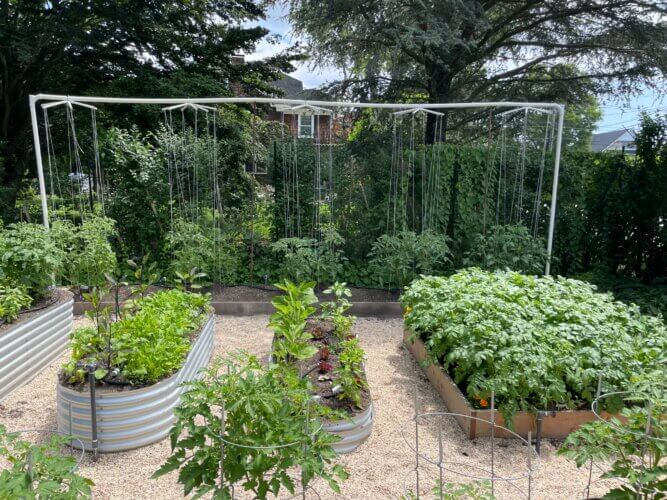
While Ayoub cut his chops at Baron’s Cove, he received no formal education, just “the school of hard knocks,” he says. “When I was, I think 13 years old, my next-door neighbors in Bay Ridge . . . they owned Woods Deli. I used to go peel potatoes.”
Even as a kid, he enjoyed a garden. “I always, always, always had a garden, and now, let’s face it, as you get older, you get a little bit more refined.”
He collects tomato seeds from throughout the world and is involved with a couple of online groups that trade seeds.
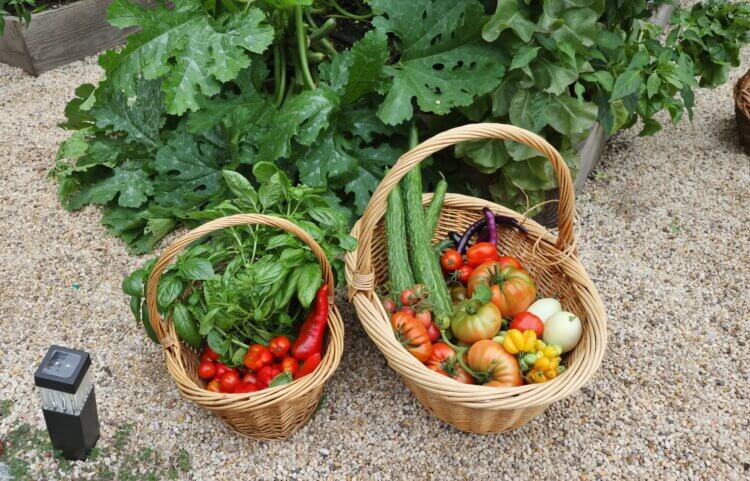
“I start off each season with about 50 varieties. I have a basement set up with a pretty elaborate set of lights that we start off these seedlings. Out of those 50 varieties, I’ll probably start with about a little over 400 seedlings,” he says.
“They’re much different than the commercial varieties that you find in the stores or in the garden centers,” he says. “I have ones this year that are tremendous — I mean, way bigger than softballs,” he says with a laugh, “bigger than my fist, you know?”
“Somebody once asked me, what’s your favorite way to eat a tomato? I said, ‘Very simple. You go out to the garden with a little container of Himalayan sea salt, you lick the tomato, put some salt on you, pop it in your mouth.’ It doesn’t get any fresher.”
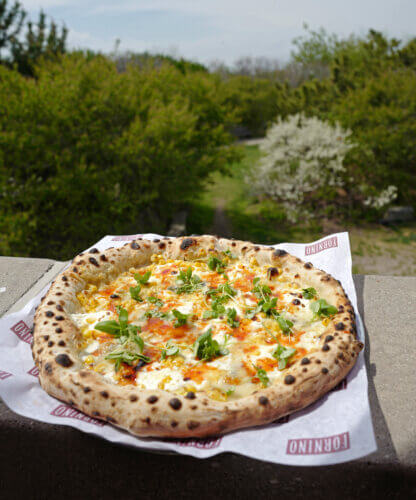
micro basil toppingsGregory DelliCarpini Jr.
The Art and Science of Pizza
Ayoub’s first restaurant was Skaffles, which he purchased in 1977 at 20 years old and ran until 1985. He then won a city bid to be the caterer for the Brooklyn Botanical Garden. By 1989, he opened the Italian restaurant Cucina, which was the first restaurant in Brooklyn to be reviewed by The New York Times.
Fornino — which was his mother’s maiden name meaning little oven in Italian — first opened its doors in Williamsburg in 2004 and that’s when he delved into his passion for making pizzas. The restaurant quickly built a reputation of having the best Neapolitan pizza in New York City, now with over 30 varieties of pizzas on the menu.
“Arguably we are the ones that created the artisanal pizza craze in the city,” Ayoub says.
He worked on perfecting pizzas — “the art and science of pizza,” he calls it, a tagline that he came up with later for Fornino.
“When I got into making pizza, everybody thinks it’s so easy, but it’s like building a widget — you’re making, you’re creating a business with one product. “I was really going down this deep, deep hole — what type of flour? What kind of protein count? Who’s gonna make the cheese? What kind of tomato? What oil?”
“It took me months and months and months to do it. That’s why I said, there’s a lot more science to this. It’s 18 years old, and I’m still learning every day,” he says of the restaurant. “I’m still playing with the dough every day.”

As any foodie knows, the ingredients, of course, make the difference. His dough, for instance, is considered low yeast and is bulk-fermented that is lighter. “When you have a pizza like that, it doesn’t give you that full in your stomach feeling…You don’t feel bloated. Let’s face it, you get a dollar slice, there’s a reason for it.”
This season, the first to be harvested from his garden was the cherry tomatoes. “I like to do just a plain pizza with just olive oil and sliced garlic on it, and some sun gold tomatoes and just bake them off, just like that. Finish it off with a little oregano and Parmesan cheese. There’s nothing fresher in the tomato flavor you can get than just a freshly cut tomato, olive oil, garlic and Parmesan cheese.”
The same goes for the larger varieties, which are in season now. They provide “a mosaic of colors, because the tomatoes range from literally white to black,” or a deep purple. He is also trying out a tomato marmalade for Fornino. “I can make it spicy, I can make it salty, I can make it sweet. And we’re gonna do that on some of our pizzas. And we’re also gonna be putting it on some sandwiches,” as the restaurants soon reopen for lunch.
Simple is always best. “I really want the flavors of these tomatoes to come through. It’s so special and it’s such a short window in the year. Gardeners work 12 months a year to get this.”
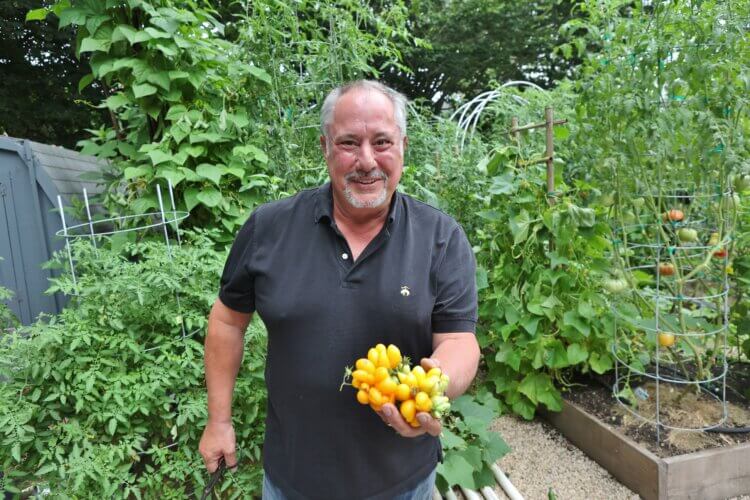
He also makes his own tomato sauce. “I haven’t bought a can of tomato sauce for the home in years, especially this time of year where we get so much bounty, you could never, you could never eat this much raw tomatoes!”
He grows more than just tomatoes. Lettuce and arugula are the first things that come up each season. There’s about 12 varieties of cucumbers, plus potatoes, yellow wax beans, herbs and peppers, which he dehydrates for toppings on pizzas, as well. He also grows a variety of eggplants, but the Italian and Asian varieties are his favorites. Mm-hmm.
“I do a Padron pepper. Padron peppers are mostly known in Spain, and they usually are eaten in small and green with tapas. But if you grow them out fully to red, they have a very big strong pimento pepper flavor, and they’ve got quite a kick to them. So what I do is I dehydrate them and you use them on pizza. The same thing with Espelette peppers, which are a French variety.”
It’s an organic garden. “You could lick the soil,” he says with a laugh. “I never put anything [chemically] in the soil. I eat here!”
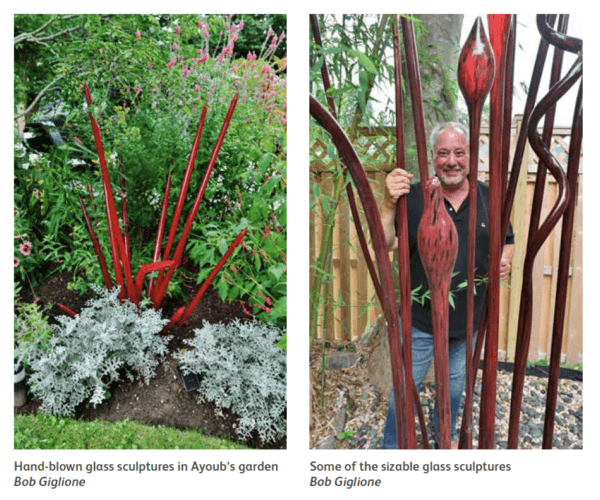
Also in the Garden
When he is not firing up the pizza ovens, he is heating something else up entirely. Ayoub is an accomplished glass artist, whose sculptures and lights are not only on display at Fornino’s flagship location in Greenpoint and at his home in Southampton, but also at Foxwoods in Connecticut and the Venetian Hotel in Las Vegas.
He took up the hobby after learning the technique of blowing sugar, a culinary art that molds shapes, such as swans on a wedding cake (as opposed to the plastic ones).
“I used to compete internationally,” he says. “And actually, I have won some international awards for blowing sugar.

About 20 years ago, he took a glass blowing classes, since the two techniques are closely related. “I loved it. The difference between glass and cooking is the permanence of a glass. No matter what I create or cook, it could take me weeks to make a sauce — It gets destroyed in minutes. You eat it, it’s consumed, it’s done. I have nothing to show for it besides the memory,” he says. “Whereas the glass, as I’m looking at it, I can remember who I blew it with, the team that I did it with, how we put this sculpture together, you know?”
With enough time these days to spend time on his hobby, he is also no longer a weekend warrior, so he is able to spend more time at his East End home and in his garden.
Though it’s protected by deer fencing, he still has to contend with those birds. “Every once in a while, if they do peck on one, I leave it there. ‘Go ahead. You win. You got it, so keep pecking on this one, and you leave mine alone.’”
This article appeared in Behind The Hedges issue on September 1, 2023. Read the full digital edition here.

